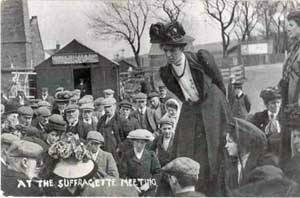Helen Fraser 1881-1975 (The Chieftainess)
 Lead the life of a normal middle class woman until she heard Theresa Billington-Grieg speak at a WSPU meeting. Joined WSPU in 1906 and soon became an organiser. Spoke at meetings all over Scotland establishing new Branches. A Scottish council of the WSPU was created with Teresa Billington-Greig as honorary secretary and Helen as Scottish organiser. In January its new headquarters opened in Glasgow. However Helen resigned later that year after Mrs Pankhurst came to Scotland to advertise her stone throwing campaign.
Lead the life of a normal middle class woman until she heard Theresa Billington-Grieg speak at a WSPU meeting. Joined WSPU in 1906 and soon became an organiser. Spoke at meetings all over Scotland establishing new Branches. A Scottish council of the WSPU was created with Teresa Billington-Greig as honorary secretary and Helen as Scottish organiser. In January its new headquarters opened in Glasgow. However Helen resigned later that year after Mrs Pankhurst came to Scotland to advertise her stone throwing campaign.
She was welcomed into the NUWSS although the GWSAWS (Glasgow and West of Scotland assn for Women's Suffrage) initially objected to her as organising secretary on account of the numbers of women she’d poached from them into the WSPU previously.
The WSPU lost its separate Scottish identity but there was no mass defection.
Helen continued her campaign tours often using Louisa Lumsden’s horse drawn caravan and later worked as an organiser in England where she became known as the ‘Chieftainess’. She remained on the NUWSS committee for 14 years.
During WW1 she worked for the government on the National War savings Committee. She insisted on being paid the same as a man. She was also seconded to the board of Agriculture to make speeches urging women to go and work on the land. In 1917 when the US entered the war she was sent to spread the word about Britain’s war effort. There were two lengthy speaking tours, which meant travelling over 40 states and included meeting President Wilson, resulted in her book ‘Women and War’.
After the war she joined the campaign to elect women to Parliament and was the first woman to be adopted as an official candidate in Scotland. She stood (unsuccessfully) as a Liberal in 1922 and 1923 before giving up party politics.
She then moved to London, earning money from freelance articles on women’s issues and sat on Kensington Council for 7 years. She remained active in the international suffrage movement.
She emigrated to Australia in 1938 where she married and wrote “A Woman in a Man’s World” (1971).
Picture: Aberdeen University.
